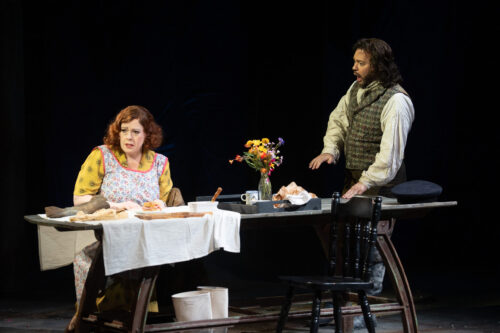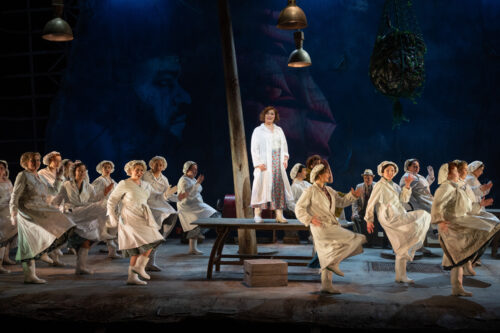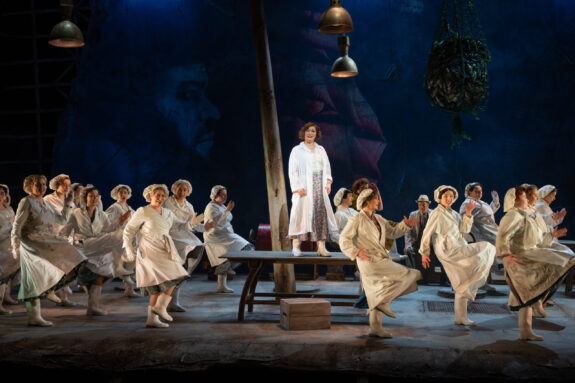 Ireland Wagner, Der fliegende Holländer: Soloists, Irish National Opera Chorus and Orchestra / Fergus Sheil (conductor). Bord Gáis Energy Theatre, Dublin, 23.3.2025. (RB)
Ireland Wagner, Der fliegende Holländer: Soloists, Irish National Opera Chorus and Orchestra / Fergus Sheil (conductor). Bord Gáis Energy Theatre, Dublin, 23.3.2025. (RB)

Production:
Director – Rachael Hewer
Set & Costume designer – Francis O’Connor
Lighting designer – Howard Hudson
Projection design – Neil O’Driscoll
Choreographer – Stephanie Dufresne
Chorus director – Richard McGrath
Cast:
The Dutchman – Jordan Shanahan
Senta – Giselle Allen
Daland – James Creswell
The Steersman – Gavan Ring
Mary – Carolyn Dobbin
Erik – Toby Spence
Little Senta – Caroline Wheeler
This performance of Der fliegende Holländer was Irish National Opera’s first Wagner production (I hope the first of many!). The production was made in collaboration with Garsington Opera, where it is scheduled to be performed at an upcoming season.
Wagner was inspired to write the opera following a stormy sea crossing which he and his wife made from Riga to London. At one point, their ship had to take refuge in the Norwegian fjords. The picturesque landscape clearly made a significant impression on Wagner as it was to become the location for Der fliegende Holländer. Wagner’s libretto is based it on a satirical story by the Jewish writer Heinrich Heine. Tales of the Flying Dutchman and his ghost ship dated back to the eighteenth century. However, Wagner was particularly drawn to the idea in Heine’s version that the Dutchman can only be redeemed by the love of a faithful woman. The opera represents a transition from the established norms of nineteenth-century opera to Wagner’s later music dramas and it is the earliest of his works to be performed so far at Bayreuth.
Rachael Hewer’s production sets the action in a remote fishing village in the middle of the twentieth century. There have been several productions of this opera where the sea does not feature at all, and it was a good idea to go back to basics, given the prominence of the sea in this work. Francis O’Connor’s set was fairly static and consisted of a lookout mast and wheelhouse in the first act. The latter was replaced by a lighthouse in the second half of the opera, and this provided a striking vantage point for Senta to make her leap into the sea at the end. Sails billowed across the stage at various points and the blood red sails of the Dutchman’s galleon provided an arresting visual image signalling his arrival.
During the Overture, a film of a ship making its way through the waves was projected on to the back of the stage. A young girl representing Senta as a child came on to the stage wearing a bright red coat accompanied by women from the village. The youthful Senta was immersed in a book and was no doubt drinking in tales of ghost ships and sea squalls. I liked the idea of planting a seed about the Dutchman in young Senta’s mind. The adult Senta also wore a bright red coat at the end of the opera which helped to reinforce the link between the two incarnations of the character.

The costumes were colourful and varied and helped to convey the location and time period for the production. The men wore oilskins while the women in Act II wore white fishmonger uniforms and aprons. During the Spinning Chorus the women formed a production line and were seen fileting fish. The Dutchman’s costume was clearly from a different time period although it was a little bland and I wondered if there was scope for him to wear something more eye-catching.
The cast were firing on all cylinders for this production and did a terrific job. American baritone, Jordan Shanahan, was dark and imposing as the Dutchman although this was a relatively sympathetic portrayal of the character. He imbued the Dutchman with pathos as he recounted his fate, and he displayed a resigned nobility in the final stages of the opera when he saw Senta and Erik together. Shanahan also displayed a lighter side of the character when he spoke to Daland about his daughter. His voice was powerful and resonant throughout the vocal range and his diction was excellent. He conjured up dark vocal timbres in his Act I aria while in the Act II duet with Senta he captured the ambivalent, conflicted nature of the character.
Northern Irish soprano, Giselle Allen, was equally impressive in the role of Senta. She sang her Act II ballad with power and conviction and was an imposing figure on the stage. She produced some thrilling top notes as the performance progressed and projected above large orchestral forces. The singing was not quite as polished towards the end of the second act and the tone occasionally sounded a little forced. Allen recovered well in the final act and delivered a thrilling denouement to the opera.
The rest of the cast all acquitted themselves well. Toby Spence conveyed brilliantly Erik’s increasing sense of desperation as he tried to prise Senta away from the Dutchman. He sang with great beauty of tone and lyricism, particularly in the third act, although I would have welcomed greater vocal heft. James Cresswell seemed perfectly to embody the worldly, avaricious Daland. His singing was robust and virile, although there were also some lighter touches in his Act I duet with the Dutchman. Gavan Ring’s Steersman and Carolyn Dobbin’s Mary also acquitted themselves well. Ring’s bright, ringing tenor voice was perfect in the Steersman’s Act I aria while Dobbin injected some well-judged humour into the opera.
The chorus has a central role in this opera and the INO Chorus rose to the occasion. The female chorus blended beautifully in the Spinning Chorus and produced a lush, radiant sound while the men brought dynamism and energy to their Act III chorus. They also treated the audience to some nifty and entertaining dance moves choreographed by Stephanie Dufresne. The transformation of the male chorus into the Dutchman’s ghostly crew was a coup de théâtre and one of the highlights of the opera.
Fergus Sheil ensured cast, chorus and orchestra remained on track throughout the production. He coaxed swirling, elemental sonorities from the INO Orchestra in the Overture with some prominent contributions from the horns. The balance between the singers and the orchestra was not always perfect although Wagner sometimes wants the soloists to soar above large orchestral textures. The orchestra really caught fire at the end of the third act when the phantom sailors make their appearance. The way in which Sheil ratcheted up tension from that point onwards was particularly impressive.
This production is another resounding success for Irish National Opera. Can I make a plea that we get opportunities to hear other Wagner operas in the not-too-distant future?
Robert Beattie
